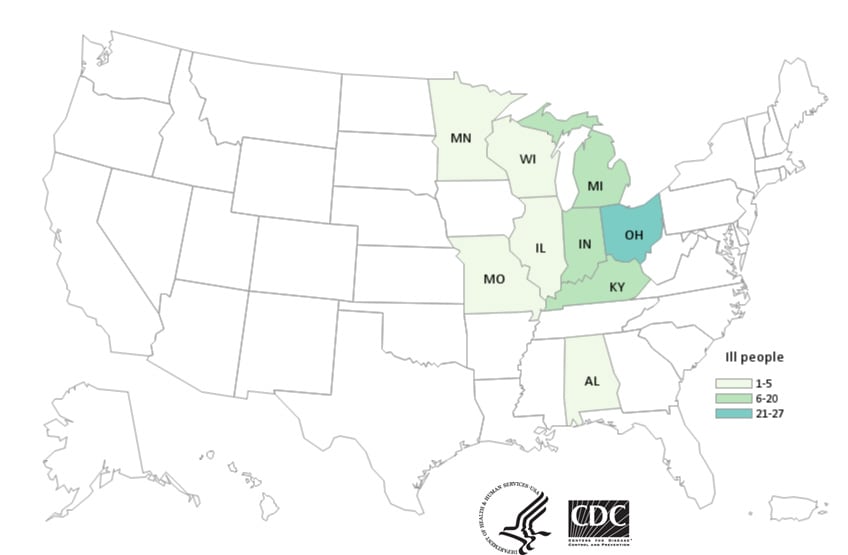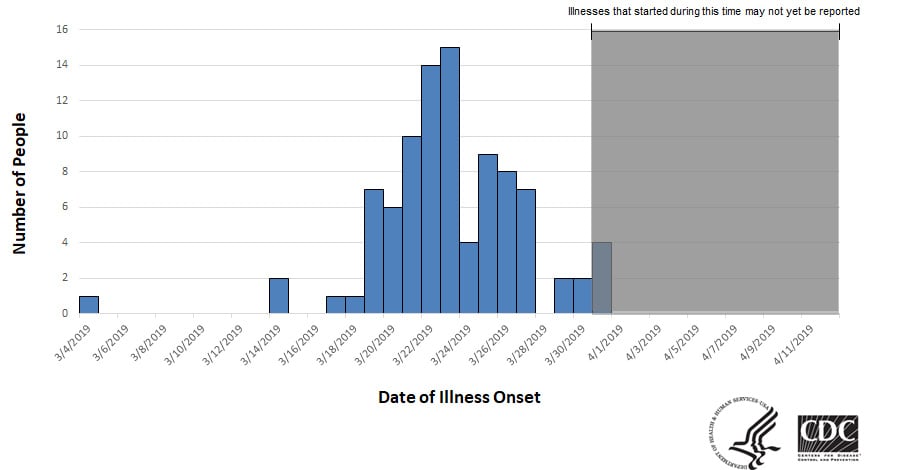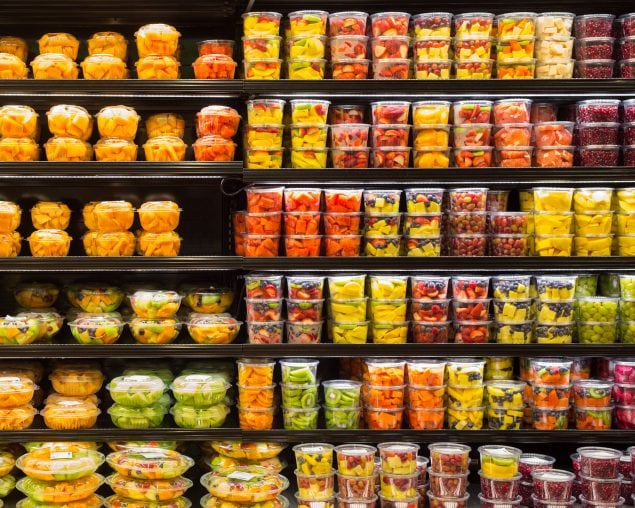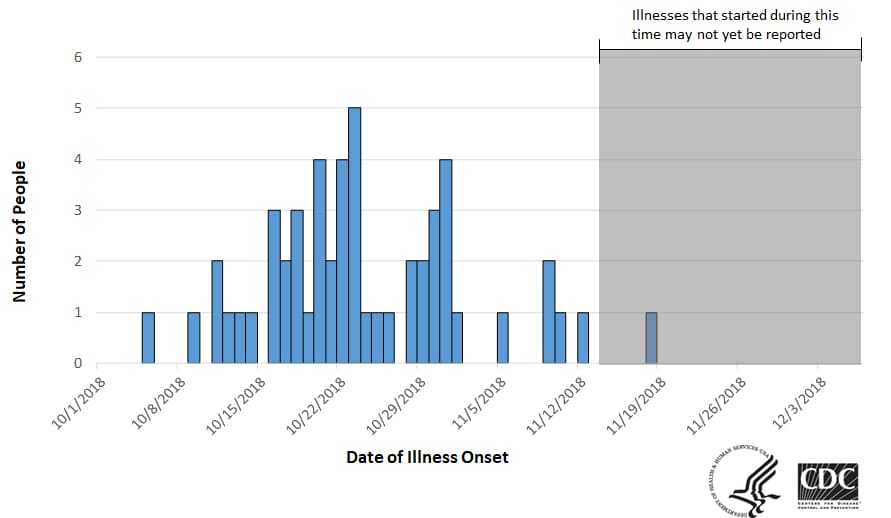Archive for the ‘Food-borne diseases’ Category
A total of 156 people infected with the outbreak strain of E. coli O103 have been reported from 10 states.
Thursday, April 25th, 2019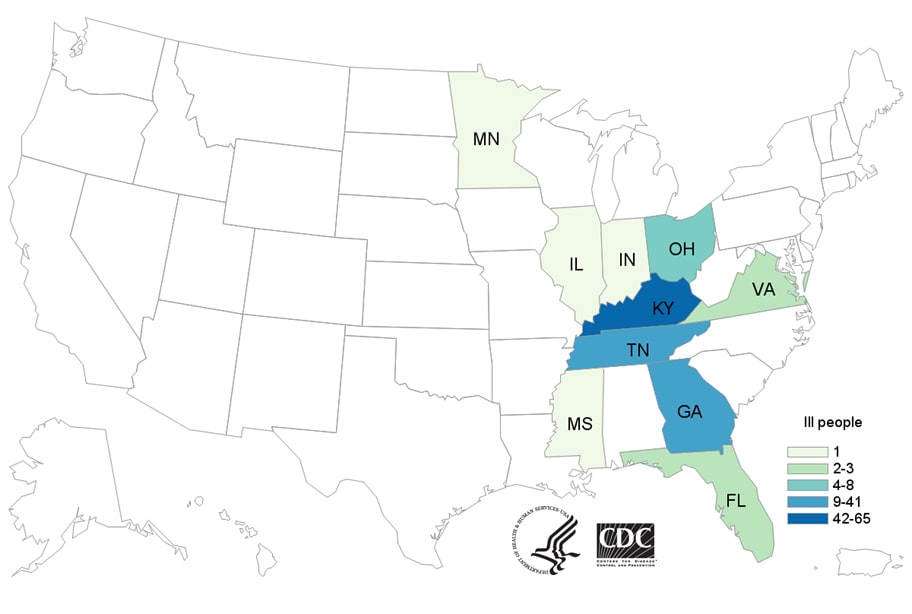
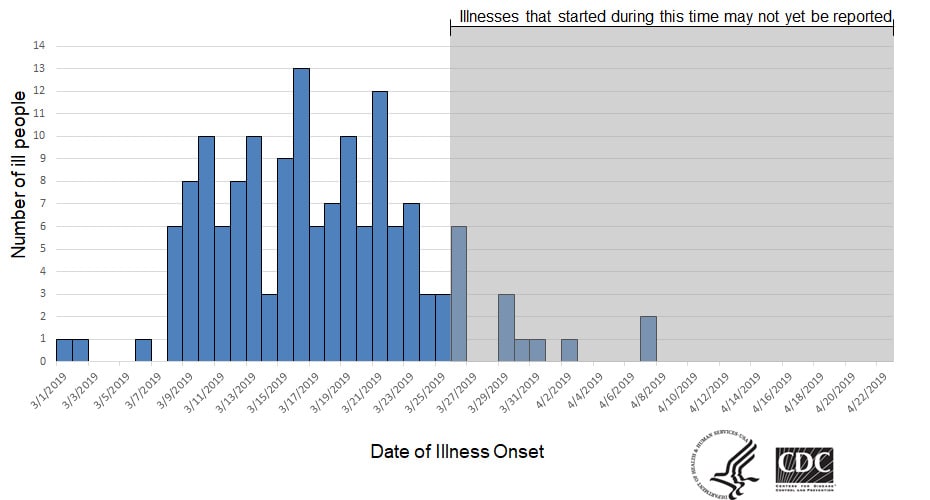
People infected with the outbreak strain of Salmonella Carrau, by state of residence, as of April 12, 2019 (n=93).
Tuesday, April 16th, 2019France: 4 dead and 15 in ICU after a presumed food poisoning at a retirement home
Wednesday, April 3rd, 2019‘…….”Prosecutors have been informed that there is a strong suspicion of food poisoning,” said deputy mayor Frederic Pasian.
“The residents all had symptoms at around 8pm – an hour and a half after their meal,” Mr Passian added, saying many were “vomiting and displaying other serious symptoms related to their meal.”…..’
CDC: 3 Types of Post-Disaster Poisonings
Wednesday, March 20th, 2019
National Poison Prevention Week (March 17-23) was started in 1962 to encourage Americans to “learn of the dangers of accidental poisoning and to take such preventive measures as are warranted by the seriousness of the danger.†Fifty-seven years later, those threats—and probably some new ones—to personal and public health persist. They can also be prepared for and—in many cases—prevented.
Here are three types of post-disaster poisonings that you should be aware of, and three ways to prepare your health for each.
Carbon monoxide poisoning
Carbon monoxide (or CO) is a silent killer. You can’t see it, smell it, or taste it; yet, there it is any time you burn gasoline, natural gas, charcoal, or kerosene in a car, generator, furnace, grill, or space heater.

Unintentional, non-fire related carbon monoxide (or CO) poisoning takes the lives of at least 430 people and sends another 50,000 people to the emergency department in the U.S. every year. Occurrences of accidental poisonings only increase when—in the aftermath of a disaster or emergency—people try to generate power or warmth or to cook.
Articles detailing the personal health threat posed by CO in the aftermath of hurricanes have appeared in the pages of the Morbidity and Mortality Weekly Report for decades–Hurricane Sandy in 2012, Hurricane Ike in 2008, Hurricane Katrina in 2005, and hurricanes Charley, Frances, Ivan, and Jeanne in 2004. Most recently, 16 of the 129 deaths in in Florida, Georgia, and North Carolina related to Hurricane Irma in 2017, were CO poisonings.
Here are three ways you can prepare for and prevent CO poisoning after a disaster.
- Learn how to use a back-up generator safely. Place generators outside, in a dry area, and at least 20 feet from any door, window, or vent. Never run a generator inside your home or garage, even if doors and windows are open.
- Install battery-powered or battery backed-up CO detectors in your home. The U.S. Fire Administration recommends that you test your devices at least once a month. Change the batteries in your CO detectors every six months. If your detector alarms, go outside for fresh air and call 911.
- Know the symptoms of CO poisoning. The most common symptoms of CO poisoning are headache, dizziness, weakness, upset stomach, vomiting, chest pain, and confusion.
Medication poisoning
Medications are, for the most part, safe when used as prescribed and dosed as directed on the label, but there is the risk of an adverse drug event anytime you bring a medicine into the house. In the wrong hands, medicines are dangerous. More often than anyone would like, the wrong hands belong to kids. About 60,000 young children are taken to emergency rooms each year because they got into medicines.
The threat of medication poisoning in kids and adults is also there in an emergency evacuation when families are forced from their homes and into a shelter, a hotel, or the home of a friend or family. Under stressful circumstances and in unfamiliar surroundings, people can forget to practice safe medication use and storage.
Here are three ways you can prepare for and prevent medication poisoning after a disaster.
- Keep all prescription medications and over-the-counter medicines and vitamins, including your emergency supply, Up and Away and out of the reach and sight of children and pets—this includes medicines in suitcases, purses, and “grab and go†bags.
- Create an Emergency Action Plan that includes important contact information, such as phone numbers for your physician, pediatrician, pharmacist, veterinarian, and the Poison Control Center: 800-222-1222.
- Properly dispose of unused, expired, or contaminated medicines in your medicine cabinet and emergency supply. Discard medications that touched floodwater or have changed in appearance or smell. Contact a pharmacist or healthcare provider if you are unsure about a drug’s safety.
Food poisoning

Food poisoning symptoms may range from mild to severe and may differ depending on the germ you swallowed. Eating or drinking something contaminated by floodwater, for example, can cause diarrheal disease, such as E. coli or Salmonella infection.
Prolonged power outages can also affect food safety. Perishable foods, such as meats, seafood, and dairy, are unsafe to eat after being in your refrigerator when the power has been off for 4 hours or more. Researchers have identified more than 250 foodborne diseases that can cause a variety of symptoms. Some of the most common symptoms are nausea, vomiting, diarrhea, and stomach cramps.
Here are three ways you can prepare for and prevent food poisoning after a disaster.
- When in doubt, throw out any food that may not be safe to eat. That includes foods that have an unusual or unintended odor, color, or texture, foods that may have touched floodwater, and perishable foods that have not been refrigerated properly due to power outages. Never taste food to determine its safety. Food can make you sick even if it looks, smells, and tastes normal.
- Throw away wooden cutting boards, baby bottle nipples, and pacifiers if they have come into contact with floodwaters; you cannot properly sanitize them. Clean and sanitize all surfaces in your kitchen, including cutlery and countertops, that come into contact with food.
- Handwashing with soap and water is one of the most important practical skills you can learn (and teach to others) to avoid getting sick and spreading germs at all times, including before you handle food—disaster or not. The germs that cause foodborne illnesses can survive in many places around your kitchen, including your hands, utensils, and cutting boards.
Learn more ways to prepare your health for a disaster or an emergency at www.cdc.gov/cpr/prepyourhealth.
At least 133 people have died and more than 200 others have been hospitalized after consuming tainted alcohol in India
Sunday, February 24th, 2019“…..Homemade alcohol is typically brewed in villages before being smuggled into cities, where it sells for about 10 cents a glass — about a third the price of legally brewed liquor…….
https://www.youtube.com/watch?v=XUJsu5v-Vig
Human Brucella abortus RB51 Infections and the Consumption of Unpasteurized Domestic Dairy Products — United States, 2017–2019.
Sunday, February 24th, 2019Negrón ME, Kharod GA, Bower WA, Walke H. Notes from the Field: Human Brucella abortus RB51 Infections Caused by Consumption of Unpasteurized Domestic Dairy Products — United States, 2017–2019. MMWR Morb Mortal Wkly Rep 2019;68:185. DOI: http://dx.doi.org/10.15585/mmwr.mm6807a6.
“……Since August 2017, CDC has confirmed three cases of brucellosis attributed to Brucella abortus cattle vaccine strain RB51 (RB51). Each case was associated with consumption of domestically acquired unpasteurized (raw) milk products (1). Patient symptoms varied and included fever, headache, overall malaise, and respiratory symptoms. In total, at least eight persons met the probable case definition of a clinically compatible illness epidemiologically linked to a shared contaminated source …..”
Enteroinvasive Escherichia coli Outbreak Associated at a Potluck in North Carolina
Friday, February 22nd, 2019Herzig CT, Fleischauer AT, Lackey B, et al. Notes from the Field: Enteroinvasive Escherichia coli Outbreak Associated with a Potluck Party — North Carolina, June–July 2018. MMWR Morb Mortal Wkly Rep 2019;68:183–184. DOI: http://dx.doi.org/10.15585/mmwr.mm6807a5.
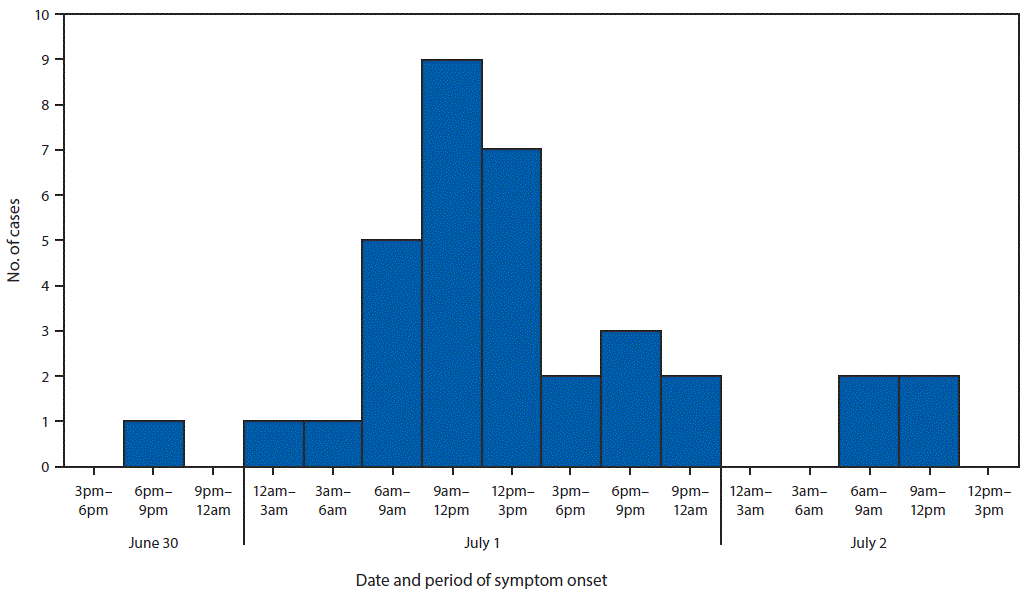
“On July 2, 2018, the North Carolina Division of Public Health was notified that approximately three dozen members of an ethnic Nepali refugee community had been transported to area hospitals for severe gastrointestinal illness after attending a potluck party on June 30. The North Carolina Division of Public Health partnered with the local health department and CDC to investigate the outbreak, identify the cause, and prevent further transmission. The investigation included molecular-guided laboratory testing of clinical specimens by CDC, which determined that this was the first confirmed U.S. outbreak of enteroinvasive Escherichia coli (EIEC) in 47 years.
A case was defined as the occurrence of diarrhea, vomiting, or fever ≥101°F (38.3°C) in a person who consumed food served at the party. Cases were identified through medical record review and retrospective cohort investigation with convenience sampling of party attendees. Among approximately 100 attendees, 52 met the case definition. Median age was 31 years (range = 3–76 years); 28 (54%) were hospitalized, including 13 (25%) with sepsis, and eight (15%) who were admitted to an intensive care unit. All patients recovered, and no secondary cases were identified.
Forty-nine persons, including 35 who were ill, were interviewed using a questionnaire to ascertain symptoms, recent travel, and food exposures. Participants also were provided with hand hygiene guidance. Among the 35 ill persons, 30 (86%) reported symptom onset on July 1, the day after the event (Figure). Median interval between eating and symptom onset was 20.5 hours (range = 1–45.5 hours). Overall, 33 (94%) ill persons experienced diarrhea, including 27 (77%), 19 (54%), and two (6%) who reported diarrhea that was watery, mucoid, or bloody, respectively. Thirty-two (91%) ill persons reported fever.
Participants reported eating chicken curry, vegetable curry, rice, lentil soup, fried bread, cold and hot salads, and cake; no imported foods were reported. No single food item was statistically significantly associated with illness; however, 37 persons reported eating chicken curry, and those who did had a 47% higher risk for illness than those who did not (risk ratio = 1.47; 95% confidence interval = 0.76–2.83). No food was available for testing…..”
Ontario, Canada: Listeria monocytogenes Associated with Pasteurized Chocolate Milk
Friday, February 22nd, 2019Hanson H, Whitfield Y, Lee C, Badiani T, Minielly C, Fenik J, et al. Listeria monocytogenes Associated with Pasteurized Chocolate Milk, Ontario, Canada. Emerg Infect Dis. 2019;25(3):581-584. https://dx.doi.org/10.3201/eid2503.180742
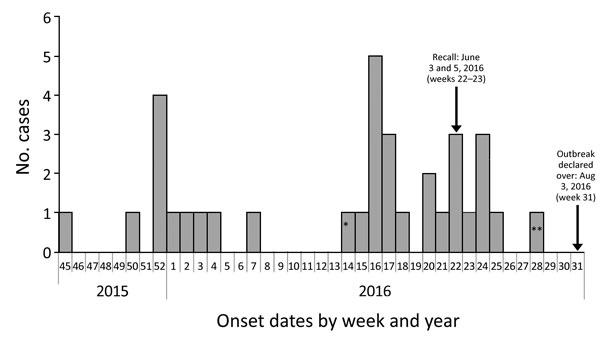
Figure 1. Outbreak cases of listeriosis (n = 34) by onset week and year, Ontario, Canada, November 2015–August 2016. Data were obtained from the Ontario Ministry of Health and Long-Term Care, integrated Public Health Information System database, extracted by Public Health Ontario, August 16, 2016. Weeks are defined according to the Public Health Agency of Canada epidemiologic week calendar. *Neonatal case-patient with symptom onset on April 4, 2016 (week 14), and illness most likely caused by mother-to-child transmission. **Asymptomatic case-patient from whom a specimen was collected on July 13, 2016, and exposure occurred before June 27, 2016 (week 28).
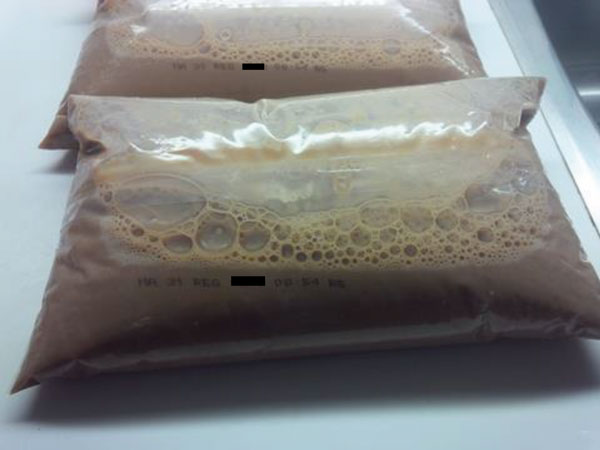
Figure 2. Bags of pasteurized chocolate milk as sold in Canada, with outer bag containing brand information removed. A bag of milk similar to these, found at the home of 1 case-patient during investigation of an outbreak of Listeria monocytogenes infection associated with pasteurized chocolate milk in Ontario, Canada, was found to be contaminated with the same strain obtained from infected patients.
Why is there a decline in Salmonella infections in NYC restaurants?
Sunday, December 16th, 2018Restaurant Inspection Letter Grades and Salmonella Infections, New York, New York, USA PDF Version[PDF – 506 KB – 5 pages]


